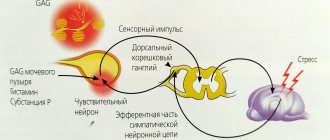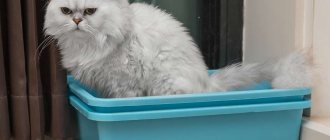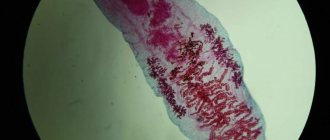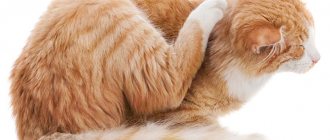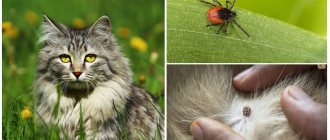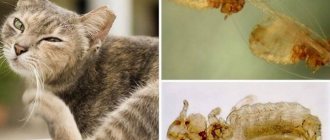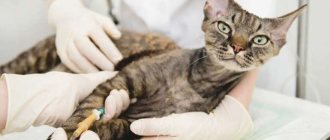Save the article:
One of the serious and common diseases in cats is cystitis. Regardless of the form in which it occurs, its manifestations cause great problems for the animal. To prevent cystitis in cats, you need to know the causes of its occurrence and preventive measures. And if the disease is diagnosed, adhere to the prescribed treatment.
global $ads_google; //data-ad-slot=”2475549904″ $ads_google = empty($ads_google) ? false : true; ?> if ($ads_google == false) {?> $ads_google = true; ?> } ?>
Description of the disease
Cystitis is an inflammation of the mucous membrane of the bladder, which is caused by pathogenic microbes (staphylococci, streptococci, mycoplasmas, chlamydia and others). Microorganisms - parasites can enter the cavity of the bladder with blood or lymph through the kidneys, as well as from the outside through the urethra. Animals regardless of breed, gender, or age can suffer from cystitis.
In some cases, with delayed or improper treatment, ulcerative and necrotic formations appear in the bladder. This entails severe complications: peritonitis, bladder paralysis, nephritis, pyelitis. With a mild course of the disease, veterinarians give a good prognosis; with a complicated and advanced version, everything depends on the therapy and the immune forces of the animal’s body.
Forms of the disease
According to the nature of the disease, acute and chronic cystitis are distinguished. The first form develops very quickly and occurs with pronounced external symptoms. The pet suffers from pain, becomes irritable, and cannot control urination. Chronic bladder inflammation is difficult to determine without special tests. It can drag on for a long time and under certain conditions, for example, with decreased immunity or hypothermia, worsen. Based on the nature of changes in the mucous membrane, cystitis in cats is divided into:
- Serous-catarrhal.
- Purulent.
- Idiopathic.
- Hemorrhagic.
With catarrhal form, cloudy mucus appears in the urine. This specific symptom is accompanied by general symptoms characteristic of most types of cystitis. A distinctive feature of the purulent form is the presence of pus in the urine. A feature of idiopathic cystitis is the complete or almost complete absence of obvious external causes for the development of inflammation. Symptoms can be either bright or blurry. With the idiopathic type, the cat’s body is so weakened that even the treatment often ends in death.
With hemorrhagic cystitis, deep inflammation of the mucous membrane occurs with damage to the capillaries. The development of this form of the disease is facilitated by urolithiasis, in which small inclusions damage the internal lining layers of the bladder and ducts. During illness, a cat's hemoglobin drops, and traces of blood appear in the urine. The hemorrhagic type occurs in both acute and chronic forms.
Types of pathology
In veterinary medicine, there are two types of cystitis:
- acute form. It manifests itself as a sharp deterioration in the functioning of the genitourinary system. The animal owner’s task is to immediately take the animal to the veterinarian for examination if signs of concern are detected;
- chronic form. Its difficulty lies in the fact that the pet rarely shows anxiety and only during urination. The owner may not notice the symptoms. This will cause the condition to worsen every day, weakening the immune system.
For your information! There are often situations when, without lack of treatment, the chronic stage turns into acute.
Causes of cystitis
global $ads_google;
//data-ad-slot=”2475549904″ $ads_google = empty($ads_google) ? false : true; ?> if ($ads_google == false) {?> $ads_google = true; ?> } ?> An infectious focus in the bladder develops under conditions favorable for pathogenic microorganisms. This is facilitated by both external factors associated with the pet’s lifestyle, as well as the functioning of the body itself. The causes of bladder inflammation in cats are:
- Poor eating and drinking conditions, resulting in the formation of urinary stones that injure the mucous walls.
- Infection in neighboring organs and tissues, transmitted through the blood and lymph to the bladder.
- A stressful condition that weakens the body’s immune status.
- Hypothermia of a cat in drafts, in a cold room, outside in rainy weather.
- Decreased immunity due to previous diseases, lack of vitamins and minerals.
- Use of non-sterile instruments during bladder catheterization.
Predisposing factors contribute to the development of cystitis in cats: injuries to the abdomen or back, physiological urinary retention, hyperemia of the bladder walls, irritation of the excretory organ with medications. Subject to hygiene standards, diet and quality of food, and conditions for keeping the cat, the risk of developing an inflammatory process is significantly reduced.
Symptoms of cystitis in a cat
The very first signs of acute cystitis are: decreased appetite, increased body temperature, decreased activity. These changes may indicate the presence of inflammation in the body without indicating the exact location of the infectious process. The pet becomes indifferent to its favorite treats, spends a lot of time half asleep, and its thirst increases. Next, the animal develops signs characteristic of cystitis:
- frequent urination;
- small amounts of urine;
- restlessness when urinating;
- dark yellow color of discharge;
- the presence of blood or pus in the urine;
- heavy ammonia odor of urine;
- abdominal pain.
global $ads_google;
//data-ad-slot=”2475549904″ $ads_google = empty($ads_google) ? false : true; ?> if ($ads_google == false) {?> $ads_google = true; ?> } ?> The urge to urinate ends with the cat moaning. The pain is paroxysmal in nature. They occur as a result of spasm of the urinary sphincter. This sign of inflammation may coincide with the symptom of urolithiasis, so to clarify the diagnosis, the help of a specialist is necessary.
Frequent urges are often accompanied by urination directly on the floor, since the sick animal does not have time to reach the tray. The urine becomes concentrated and therefore changes color. The cat does not allow you to touch its belly; avoids climbing into a person’s arms; spends little time lying on his stomach. The signs of chronic and acute cystitis are the same, the differences are only in the frequency of urges.
IMPORTANT!
When the first symptoms of cystitis appear, indicating that your pet is unwell, you should contact a veterinary clinic.
Diagnosis of cystitis
Only a veterinarian can diagnose cystitis after examining the cat and conducting laboratory tests. The examination includes palpation, biochemical, microbiological and cytological analysis of the animal’s blood and urine. It should be remembered that home diagnosis, as well as self-treatment, can lead to serious complications.
When palpating the lower abdomen through the abdominal wall, the cat experiences tension and pain. In this case, the bladder is often empty. If necessary, the doctor prescribes an ultrasound examination. It helps determine the degree of advanced cystitis in a cat and the presence of additional inclusions in the bladder.
An indicative diagnostic sign is the amount of urine. If the inflammation has not affected the kidneys, then the total daily volume of fluid excreted does not decrease. Laboratory testing shows the presence of protein, mucus, epithelial cells, and red blood cells in the urine. A sick animal has a significantly increased number of leukocytes. Microbiological culture also confirms the presence of fungal and bacterial flora.
General provisions
The syndrome, which indicates a pathology of the lower urinary tract, may be accompanied by pollakiuria, hematuria, periuria - when the cat urinates outside the tray.
Urological syndrome, in general, in addition to its idiopathic nature (more often in young cats), can have the following causes:
- bacterial;
- stone obstruction (with or without infection).
The last two points apply to cats over 10 years of age, which is why the treatment of young and old animals cannot be identical. Despite the fact that the symptoms are very similar. It is not enough to make a diagnosis; it is important to study all the moments that preceded the onset of the syndrome!
In studies that were carried out in America at the end of the 20th century, it was found that in 65% of cases the causes of the characteristic symptoms of damage to the lower urinary tract in cats were never found. That is, cystitis was idiopathic in nature. Moreover, the animals had various accompanying problems - stones, bacterial infection, etc. But they were interpreted as subsequent, accompanying signs, but not as the true cause of the disease.
Treatment of bladder inflammation
global $ads_google;
//data-ad-slot=”2475549904″ $ads_google = empty($ads_google) ? false : true; ?> if ($ads_google == false) {?> $ads_google = true; ?> } ?> To restore health, comprehensive treatment is necessary, including medication and home care. The course must be prescribed by a veterinarian. The list of measures necessarily includes antibacterial therapy, for which tablets or injections are used. When treating cystitis in cats, antispasmodic and analgesic medications are simultaneously prescribed to relieve pain.
If necessary, the pet's bladder is cleansed of infectious contents. To do this, warm saline solutions, for example, sodium chloride, and then antiseptic solutions are injected into the organ cavity using a catheter. Washing is repeated until the emerging liquid has a transparent color. If the body is severely dehydrated, the animal is given drips with a saline solution, which restores the water-mineral balance. In some cases, glucose is administered. The number of droppers depends on the volume of urine excreted per day.
A veterinarian should prescribe medications for cystitis and treat them, since he has information about the compatibility of drugs and the cat’s health condition. Knowing about the presence of concomitant diseases, the specialist can adjust the standard treatment regimen. The task of the owner of a fluffy cat is to follow the purpose and create optimal home conditions.
Establishing diagnosis
The correct diagnosis of feline idiopathic cystitis and the effectiveness of treatment largely depend on the correct and timely diagnosis. The veterinarian’s ability to collectively assess the existing symptoms guarantees a good result. A detailed medical history is required for an accurate diagnosis.
Difficulties in diagnosing the disease lie in the need to exclude other diseases, such as urolithiasis and infectious cystitis.
X-ray examination allows you to examine the entire length of the urethra. If, with symptoms of obstruction or blockage of the urethra, no stones are found in the ureter, most likely the cause is idiopathic cystitis.
Additionally, a urine test is necessary to exclude the infectious nature of cystitis.
Medicines for cystitis in cats
global $ads_google;
//data-ad-slot=”2475549904″ $ads_google = empty($ads_google) ? false : true; ?> if ($ads_google == false) {?> $ads_google = true; ?> } ?> To treat cystitis, medications are used that relieve the symptoms of the disease, as well as drugs that directly treat because they act on the causative agents of inflammation. In complex therapy, both groups of drugs are important. The former provide physical relief after taking the initial doses, the latter guarantee recovery. The prescribed course of treatment includes:
- Antibiotics
. The active components of the drug destroy the cell structures of microorganisms, causing their death. Even in the case of a viral or fungal cause of cystitis in cats, the veterinarian prescribes antibiotics. The reason lies in the fact that bacteria can settle in the site of inflammation a little later. The most commonly used cephalosporin sulfonamide antibiotics (erythromycin, ceftriaxone, enrofloxacin and others). These modern formulations have proven themselves in the treatment of cystitis. The duration of treatment is from 7 to 10 days, depending on the severity of the disease.
- Antispasmodics
. Medicines are necessary in case of painful urination in a cat. They relieve spasm of the urinary sphincter and thereby eliminate the pain effect. The use of antispasmodics is also justified by the fact that they increase the volume of urine. Thanks to this, fluid with toxins does not stagnate in the bladder. Most often, the animal is prescribed no-spa or papaverine by injection. Antispasmodics are used for no longer than one week.
- Probiotics and prebiotics
. Their purpose is determined by antibacterial therapy. Antibiotics destroy not only pathogenic, but also beneficial microflora. To restore it, you need products containing microorganisms beneficial to the intestines - probiotics. They are given to the cat together with prebiotics - substances that provide food for beneficial microorganisms.
- Anti-inflammatory drugs
. Their action is aimed at reducing the symptoms of inflammation, removing toxins from the lesion, and relieving swelling. This category includes Stop Cystitis and Cyston. Both products support the action of antibiotics and alleviate the cat's condition. Stop-cystitis contains exclusively herbal ingredients (extract of medicinal raw materials of nettle, lingonberry, birch, horsetail). The drug normalizes metabolism in the kidneys and bladder, thereby preventing the formation of stones.
ATTENTION!
Many medications have analogues. When replacing, you should check the dosage and regimen with your veterinarian.
Reducing stress in your cat's life.
Stress plays a very important role in the development of cystitis, so reducing anxiety has a positive effect on the cat’s well-being. In a calm environment, the cat drinks and goes to the toilet more often, which helps reduce the frequency and severity of exacerbations of cystitis. It is important that cats feel confident that they are in control of what is happening around them.
Give your cat the opportunity to freely visit the litter box. If there are several cats, each should have its own litter box (ideally even several, in different places). Try to find a suitable location and type of litter box that suits your cat. The litter box should not be in noisy or crowded places, as cats try to avoid such places.
It is important to try to identify and rule out any specific causes of stress - these could be other animals, sudden changes in diet, numerous guests, stress in the life of the cat owner, and much more. If possible, we should try to eliminate or neutralize the causes of stress.
One of the most common causes of stress, leading to exacerbation of cystitis, is conflicts with other cats. They can be very difficult to identify, but if there are several cats in the house, you should definitely consider this possibility. In some cases, to alleviate the cat’s condition, the best option would be to find new owners, since constant stress has an extremely negative impact on its health.
Cats that spend most of their lives indoors are also sensitive to stress. Compared to their wild ancestor, the African wildcat, domestic cats often live in very limited spaces with little to occupy their time and mind - such a boring existence can also cause serious stress. Quite simple measures can help combat it, for example:
- Make time to play with your cat. Do this on a regular basis, daily. Use different toys for games;
- Sometimes allow the cat to visit forbidden places - rooms, balcony, yard. The cat may be interested in this;
- Arrange the room in such a way that the cat can find something to do (for example, install scratching posts) and rest comfortably. A cat needs some territory and a comfortable place to control this territory, at least to some extent. It is important that the cat has something to explore and that there are places in which to hide - ideally at heights (for example, on cabinets and other furniture);
- To reduce stress, it may be useful to treat objects with synthetic cat pheromones from the facial glands - their smell reduces stress and calms the cat;
Maintenance and feeding during treatment
To restore strength and speed up the treatment of cystitis, the cat needs to create a calm home environment. Rest, adequate sleep, lack of stress, and abstinence from active games with your pet contribute to a faster recovery. The cat cannot be taken to exhibitions or for mating for up to three months after complete recovery. During therapy, the pet should be in a warm room without drafts. The ideal mat for a cat is a warm bed with high walls.
When going to the veterinary clinic and for the first time of treatment for cystitis with uncontrollable urges, it is recommended to put a diaper on the cat. This attribute changes as it is filled. Typically, two diapers per day are enough for an adult. For cats weighing from 2 to 4 kg with a belly girth of less than 35 cm, size S diapers are suitable. For larger cats - weighing up to 7 kg and a belly girth of up to 48 cm, size M is needed.
global $ads_google; //data-ad-slot=”2475549904″ $ads_google = empty($ads_google) ? false : true; ?> if ($ads_google == false) {?> $ads_google = true; ?> } ?>
The animal should always have clean drinking water within its reach. Drinking plenty of fluids helps reduce urine concentration and actively eliminate toxins and drug half-lives. If the analysis shows acidification of the urine, then baking soda (sodium bicarbonate) must be added to the drinking water. For 1 liter of liquid, 5-7.5 g of powder is enough. When alkalizing urine, a decoction of bearberry leaves has a good effect.
Suitable feed
A balanced, nutritious diet provides the cat’s body with the entire complex of nutrients and biologically active substances. For a weakened animal, it is necessary to choose premium dry and wet food or special formulations intended for cats with diseases of the excretory system.
The formulation of veterinary feeds is developed taking into account the needs of the sick organism. They contain easily digestible substances with the required acidity. This diet prevents the formation of urinary stones and helps dissolve existing solids. The amount of minerals in specialized feeds is reduced. This makes the urine less concentrated. Ready-made food for cats has a slight diuretic effect, which promotes better removal of toxic substances.
global $ads_google; //data-ad-slot=”2475549904″ $ads_google = empty($ads_google) ? false : true; ?> if ($ads_google == false) {?> $ads_google = true; ?> } ?>
For diseases of the distal excretory system, experts recommend food from the Urinary Feline or Urinary Care category. They are found in well-known cat food brands Royal Canin and Hill's. This therapeutic dietary food is not suitable for all pets, as it has restrictions on its use. The list of contraindications includes pregnancy, lactation, chronic heart and kidney failure, hypertension, acidifying therapy.
If the menu is made up of natural food, then milk, meat broths, and cereals are chosen for feeding. The diet should consist of easily digestible and non-irritating foods. Fatty ingredients that create increased stress on the digestive and excretory organs are excluded.
Struvite and phosphates
Phosphate stones form in alkaline urine, so you need to use products that acidify it. In this situation, you need to increase the amount of protein in your diet. But only those feeds that have a reduced amount of magnesium, phosphorus and calcium are suitable.
Feeding cats for constipation
Feeding cats with hepatitis
Feeding cats with diarrhea
Phosphate stones form in alkaline urine, so you need to use products that acidify it. In this situation, you need to increase the amount of protein in your diet. But only those feeds that have a reduced amount of magnesium, phosphorus and calcium are suitable.
Important! It is necessary to increase the amount of sodium in the diet, for which food must be added.
It is necessary to exclude from the diet:
- green foods: cucumbers, cabbage, broccoli, cauliflower and others;
- legumes: peas, beans;
- milk and fermented milk products: cottage cheese, cheeses, feta cheese, kefir;
- nuts: sesame, almonds, hazelnuts and others;
- fish: sardine, pollock, tuna, sturgeon, horse mackerel and others;
- seafood: crabs, squid, shrimp;
- cereals: buckwheat, barley, oatmeal and millet.
You need to give preference to meat and protein foods:
- Any meat can be given except pork, as it is too fatty. It’s better not to feed chicken either, because there are often allergies to it. You can buy rabbit meat from cheap meat. Before feeding, it must be thoroughly boiled or frozen.
- Since meat is quite expensive, it can be replaced with meat by-products. These include the lungs, kidneys, heart, udder, rumen and other internal organs. They also need to be thoroughly cooked or frozen for 2-3 days. You should not give bones to your cat.
- You can feed egg whites without the yolk, since the yolk contains many carbohydrates, fats and cholesterol. It is advisable to boil eggs rather than fry them. The animal will most likely refuse to eat raw protein.
- If you don’t have money, an interesting way out of the situation would be to buy sports nutrition. Protein concentrates have a good composition (low chemical content), a large amount of proteins with a minimal concentration of fats and carbohydrates. And also at a fairly low price when compared with meat. You can prepare concentrates in the same way as egg whites.
Prevention of cystitis in cats
To prevent primary inflammation or relapse, it is important to remember preventive measures. At their core, they are “antipodes” of causes that create a favorable background for the development of the disease. Firstly, the cat should always be in an environment with a comfortable temperature. To do this, it is necessary to protect the animal from drafts and prolonged exposure to the street in bad weather conditions. Particular attention should be paid to the cat after bathing, as wet fur contributes to hypothermia.
Secondly, daily nutrition should be prepared taking into account the age, breed and physiological state of the animal (pregnancy, lactation, old age, health problems). Thirdly, the cat’s water bowl should always be full. It is unacceptable to leave her without drinking, as this affects the functioning of the excretory organs. Fourthly, the cat’s vaccination schedule must not be disrupted, as this directly affects the cat’s immunity.
Cystitis in cats is a serious disease that, if untimely and improperly treated, can lead to life-threatening consequences for the pet. To avoid problems, you should be attentive to the well-being of the animal. The good health of a pet is a guarantee of its long life and peace of mind for its owners.
